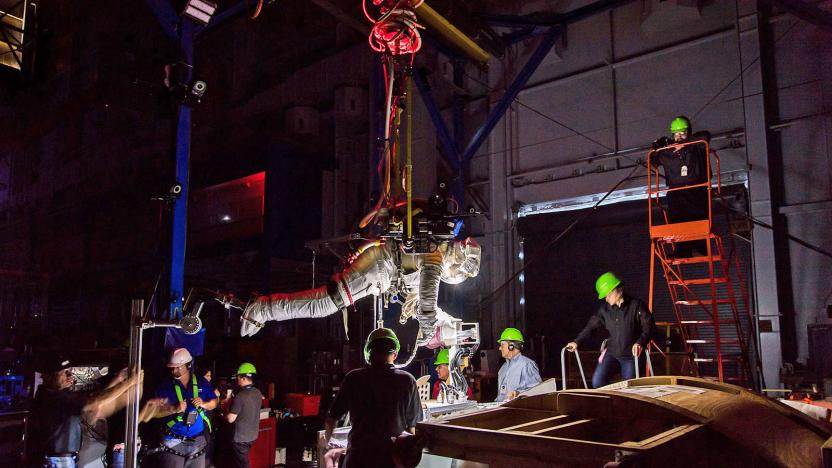microgravity
Latest

NASA, ESA will study how artificial gravity can keep astronauts healthy
Astronauts aboard the International Space Station have to exercise and alter their diet to endure extended stays in microgravity, but NASA and the ESA hope to find a better way. They're about to start a study that will explore how artificial gravity might keep astronauts in good shape. Volunteers at the German Aerospace Center will spend 60 days in bed starting on March 25th at an incline that will send blood away from their heads. Once a day, a "selection" of the subjects will take a spin in the Center's short-arm centrifuge in a bid to send blood back toward their legs.

Learning to fly with NASA's spacewalk simulator
What you're looking at is not a production set photo from Gravity, but rather a training simulation for Canadian Space Agency astronaut Jeremy Hansen. He's suspended over a mockup of the International Space Station (ISS), while attached to the Active Response Gravity Offload System (ARGOS) at NASA's Johnson Space Center in Houston, Texas. For this particular session, engineers ran tests in both light and darkness to simulate the 90 minute day/night cycles experienced by orbiting astronauts.

Next Blue Origin rocket carries two microgravity experiments (update: success)
We only just found out that Jeff Bezos & Co. are planning another round trip rocket flight for tomorrow, and now they've announced something extra. This time around the New Shepard vehicle will be carrying two microgravity experiments. Being able to conduct science not possible on Earth is part of Blue Origin's pitch for its rockets, and each setup takes advantage of the flight in different ways.

Scientists learn to build better metals by freezing alloys in space
Metals are full of microscopic structures that define properties like strength, but it's hard to figure out how those structures work on Earth, where gravity skews their effects. An experiment aboard the International Space Station may have solved that dilemma, however. By freezing alloys in the station's extra-low gravity, scientists tracked the growth of microstructures in a pure environment and revealed a wealth of data about how metal forms. For example, the structures sometimes "breathe" (really, ripple) as they grow -- if you're not careful when producing metal, those tiny shapes will either break or disappear altogether.

NASA, Roscosmos pick seasoned astronauts for year-long ISS trip
We now know which two astronauts will have to pack their bags very, very well in the next three years: NASA's Scott Kelly and Roscosmos' Mikhail Kornienko have been picked for the year-long stay aboard the International Space Station in 2015. Both voyagers are old hands at space travel, having each spent a total of six months in orbit and at least some time on the ISS crew. There's no great shock in the choices when the mission will track the long-term effects of near-zero gravity on the human body -- after all, most of us would want a crew comfortable in its spacesuit boots for such an ambitious (though not record-setting) trip. Kelly and Kornienko will start a two-year training program shortly into 2013 that should have them in shape by the expedition's launch... and hopefully remind them to bring a good toothbrush.

ISS ready for new zero-g experiments, students asked to float ideas
Those secret space experiments you've been scheming? They may never happen if you try to go it alone. Fortunately, the space science group NCESSE can get you a ride, having started the countdown for its fifth wave of microgravity experiments aboard the International Space Station. US and international students from grade 5 up to university level can submit ideas until September 12th, 2012, with final culling by December 7. The mini-labs -- which can include experiments in seed germination or crystal growth, for example -- are set to be ferried aboard a SpaceX flight in April 2013. Three similar missions have flown nearly 60 student experiments already, with a fourth set as soon as the Falcon 9 craft deigns to go. If you've got a flat-out good idea being prevented by big G, hit the source to see how you could get it fired off to the ISS.

NASA makes longer, straighter piezoelectric nanowires in microgravity, no flat iron needed
Piezoelectric nanowires are the stuff that make power-generating pants a possibility, and that prodigious potential has drawn the attention of NASA. You see, self-powered spacesuits are awfully attractive to our nation's space agency, and a few of its finest student researchers have discovered that the current-creating strands of zinc oxide can be made longer and straighter -- and therefore more powerful -- when freed from gravity's unrelenting pull. That means nanowires grown in microgravity could lead to higher capacity batteries and the aforementioned juice-generating interstellar garb. Of course, there's no such end-products yet, but let's see if NASA can do what others have not: give pants-power to the people.



